Organizations today suffer from a severe disability when it comes to solving problems. In virtually every organization, regardless of mission and function, people are frustrated by problems that seem unsolvable. Every attempt to resolve a problem results in unintended consequences that dwarf the original one. Relationships worsen as people harden into opposing positions, each side insisting on its own solution, unwilling to consider alternatives. Too many problemsolving sessions become battlegrounds where decisions are made based on power rather than intelligence.
Consider the language used to describe problem-solving. We “attack the problem,”, “tackle the issue,”, “take a stab at it,”, “wrestle it to the ground,” “get on top of it.” If colleagues argue with us, we complain that they “shot down my idea,”, “took pot shots at me,”, “used me for target practice,” or that “I got killed.” In the face of opposition, we “back down,”, “retreat” or “regroup.” (Sometimes there are gentler metaphors in use—we may “float an idea” or test it to see “if it has legs.”) Such aggressive descriptions of problem solving point to a startling conclusion. We experience problem-solving sessions as war zones, we view competing ideas as enemies, and we use problems as weapons to blame and defeat opposition forces. No wonder we can’t come up with real lasting solutions!
Aggressive problem-solving techniques manifest in subtle ways as well. Nearly every problem faced by an organization is exceedingly complex. Yet we act as if simple cause and effect is at work. We push to find the one simple reason things have gone wrong. We look for the one action, or the one person, that created this mess. As soon as we find someone to blame, we act as if we’ve solved the problem. Of course, it’s always someone else’s fault, never our own. This is the one real joy of scapegoating—we walk away, and somebody else or their project takes the hit. Finding others to blame is the only reward of simplistic thinking.
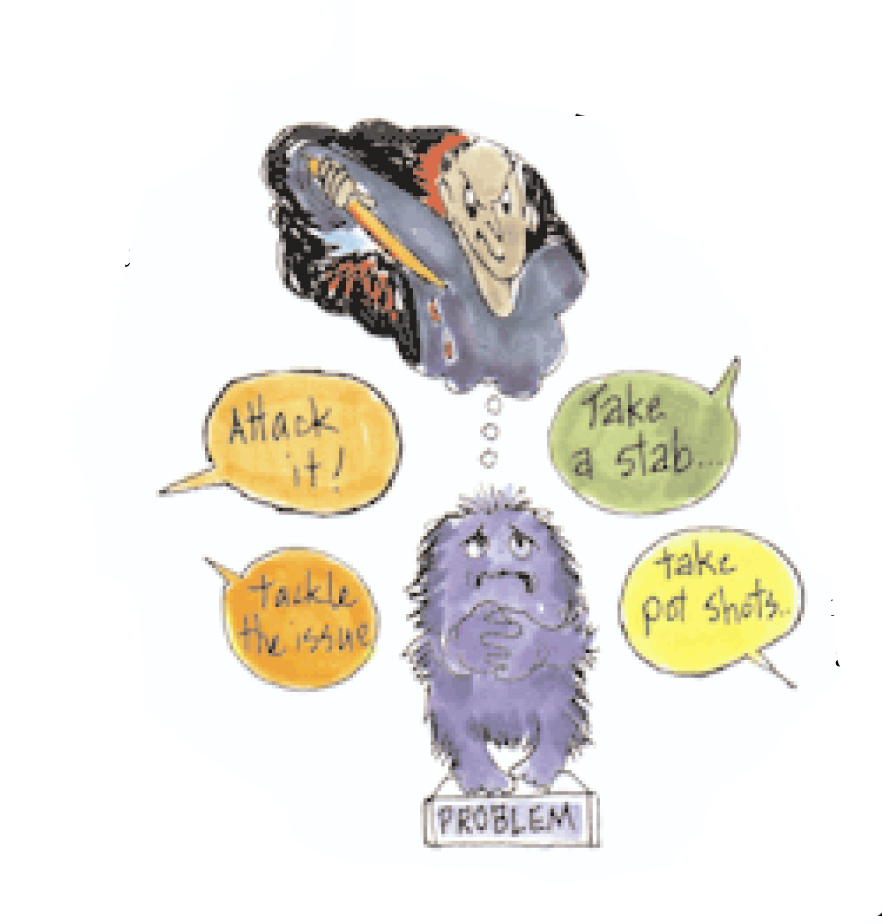
But satisfaction at naming the scapegoat is momentary. Long-term, we’ve set in motion a number of disastrous unintended consequences that create an impotent and hostile organizational culture. In a culture of blame, people become protective and reactive, striking out in selfdefense. Innovation and risktaking vanish. What arises are hardened positions, stronger factions, alliances, even cabals. As polarization takes hold, appreciation for diverse viewpoints disappears. People trust only those who think like they do. Real information goes underground, and only angry gossip and paranoid rumors make it to the light of day. Passive aggression grows stronger in calculated strategies where people stonewall, delay, and sabotage. Thinking shrinks to moment-by-moment reactions, and long-term strategic thinking disappears. Everybody needs to protect themselves, and nobody thinks about the whole enterprise.
This sorry state of affairs is quite predictable. Aggression only breeds more aggression. It only creates more fear and anger. It is impossible to avoid this deteriorating cycle as long as aggressive tactics are pursued. What has been less evident is that our approaches to problem solving are inherently aggressive. We haven’t noticed how our attempts to solve problems by seeking simplistic causes, by treating problems as enemies, by needing to assign blame are contributing to the increasing number of problems we face and the deterioration of an organization’s or community’s capacity to work together.
There are healthy alternatives to this aggressive approach to problem solving. But before detailing a fivestage process, let’s observe for a moment the sea of aggressive energy in which we swim, blindly.
An Aggressive Society
These days, our senses are bombarded with aggression. We are constantly confronted with global images of unending, escalating war and violence. In our personal lives, we can’t help but encounter angry people cursing into cell phones, watch T. V. talk shows where guests and audiences intimidate each other verbally and sometimes physically, or attend public meetings that disintegrate into shouting matches. Aggression appears frequently in advertising images, from food products that promise to “hammer your hunger,” to a recent candy commercial where formerly benign M&M’s® became violent and beat up a noisy moviegoer to everyone else’s satisfaction.
Aggression is not only the dominant energy of this time, we regard it as a positive attribute. Parents scream from the sidelines of their children’s sports events: “Get aggressive!”
Employees are rewarded for aggressive timelines and plans. Dictionaries define “aggressive” as hostile action, but also positively as assertive, bold, and enterprising.
The predominance of aggression in our behavior and language is more than a curious trend. Aggression only moves in one direction—it creates more aggression. We quickly become locked into a deteriorating cycle of increasing rage and violence. Caught in fear and anger, we lose the capacity to respond in any other way. We strike out ever more fiercely, thus creating more frightening reactions from those we oppose.
Aggression is inherently destructive of relationships. People and ideologies are pitted against each other, believing that in order to survive, they must destroy the opposition. While this is absolutely necessary on a real battlefield, when aggression moves into our day-to-day relationships, it destroys our capacity to work and live together. Relationships fracture, distrust increases, people retreat into selfdefense and isolation, paranoia becomes commonplace. Aggressive tactics breed fear and anger, and these emotions destroy all hope for healthy communities, workgroups, families, and organizations.
Aggression in Organizations
Aggression is the most common behavior used by many organizations, a nearly invisible medium that influences all decisions and actions. What is not recognized is that aggression is one of the greatest barriers to thinking clearly and working well together during this difficult time. Aggression is evident in the consistent use of war and sports metaphors. There is constant use of these images as we “bring in the big guns,”, “dominate the field,” plan “a sneak attack,” or “rally the troops.” Recently, even email has turned violent:, “I’ll shoot you an email.”
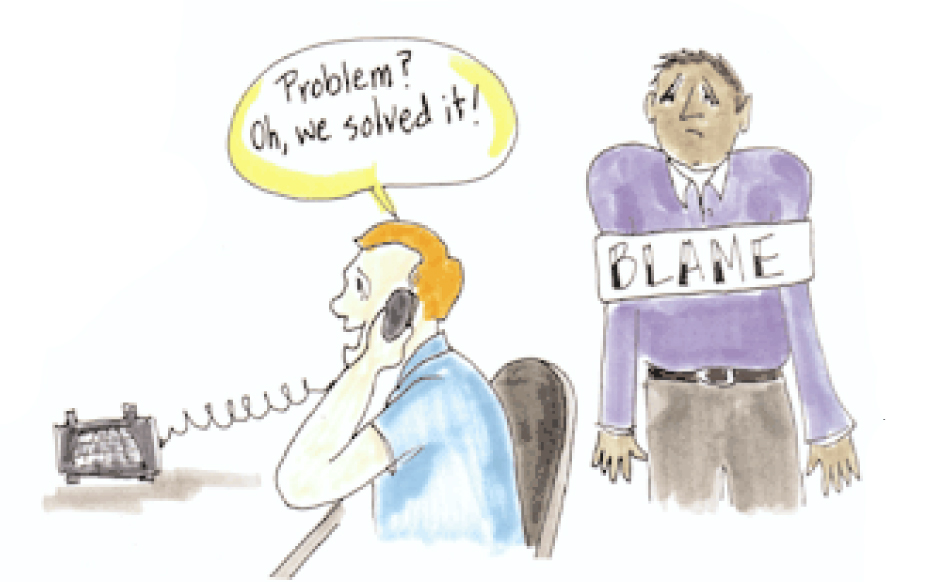
And organizational aggression is on the rise, mirroring the societal trend. Competition has become increasingly ruthless, with strategies that aim to destroy competitors and achieve total market domination rather than former strategies of coexistence within well-defined niches. The resurgence of command and control leadership is a less obvious but strong form of aggression, where the will of one person is imposed on others with the demand for obedience and compliance.
Day-to-day in organizations, there is the overt aggression in meetings, where one or two people dominate the time, railroad the agenda, and insist on their opinion or strategy. Passive aggression is also abundant, as when people use delaying tactics, when they agree to do things and then fail to act, when they refuse to respond to communications or act contrary to prior agreements, when they act secretly and fail to communicate what they’re doing, when they resort to sarcasm and cutting humor.
This increasing aggression is having a profound impact on organizational relationships. Distrust is on the rise, so much so that in one survey, managers reported that the primary reason they attend meetings is because they don’t trust what their colleagues will do in their absence. More employees are retreating into self-protective stances, hoarding resources and information for fear of losing further control of their work. And worker stress levels are at an alltime high. In Canada, one-third of And worker stress levels are at an alltime high. In Canada, one-third of lost work days are from emotional/ psychological causes.
Organizations are caught in aggression’s one-way street. Fear and anger will continue to increase unless we notice what is happening and make a choice for non-aggressive approaches. In the past, aggressive strategies were part of many organization’s cultures, but they were moderated by other practices. When we had more time available and weren’t drenched in uncertainty and fear for the unknown future, there were moderating influences on aggression, such things as participation, consensusseeking, patient problem solving, inclusion, and diversity of perspectives. But now, in this culture of speed and overwhelm, there is nothing to counterbalance aggressive practices. Yet until we choose for alternative methods, we will continue to experience increasing anger, frustration, impasse, and exhaustion.
Solving Problems Free from Aggression
For eons, humans have struggled to find less destructive ways of living together. In this present culture, we need to find the means to work and live together with less aggression if we are to resolve the serious problems that afflict and impede us. The fivestage process described here originated from an ancient teaching in Tibet. We have brought it forward, modified, and expanded it, based on our experience of working in many large, complex organizations and communities that face intractable problems. This process allows individuals and groups to disengage from aggressive dynamics, yet to use the passion and energy of all involved to develop greater clarity and insight into appropriate and effective actions.
To step aside from aggressive responses to problem solving requires using some little-used skills: humility, curiosity, and a willingness to listen. Humility is a brave act—we have to admit that we don’t know enough to solve the problem, that our approaches aren’t working and never our demands and did what we asked, the problem still would not be solved. We need more information, more insight. This kind of humility is rare in competitive, embattled organizations and communities, but it is the door we must walk through to find the place of true solutions. One wise educator put it this way:, “Humility is admitting that I don’t know the whole story. Compassion is recognizing that you don’t know it either.”
Hopefully, humility leads us up out of our bunkers, to open ground where we step away from the rigidity of our positions and become a bit curious. We need to be open to the possibility that colleagues and even strangers have information and perspectives that may be of value to us. Only with their input do we stand a chance of seeing this problem in all its complexity. Every perspective, prejudice, and opinion offers more information. If we can start to realize that we’re all on the same side—that the problem is the problem—then our different positions become a benefit that allow us to see the situation more fully.
Five Stages to Solving Complex Problems
In order to develop a rich understanding of a complex problem and determine appropriate actions to resolve it, there are five precise activities to complete in sequence. These are:
- Cooling, Quieting
- Enriching Through Fruitful Opposition
- Magnetizing Resources
- Precise Destroying
- Intelligently Acting
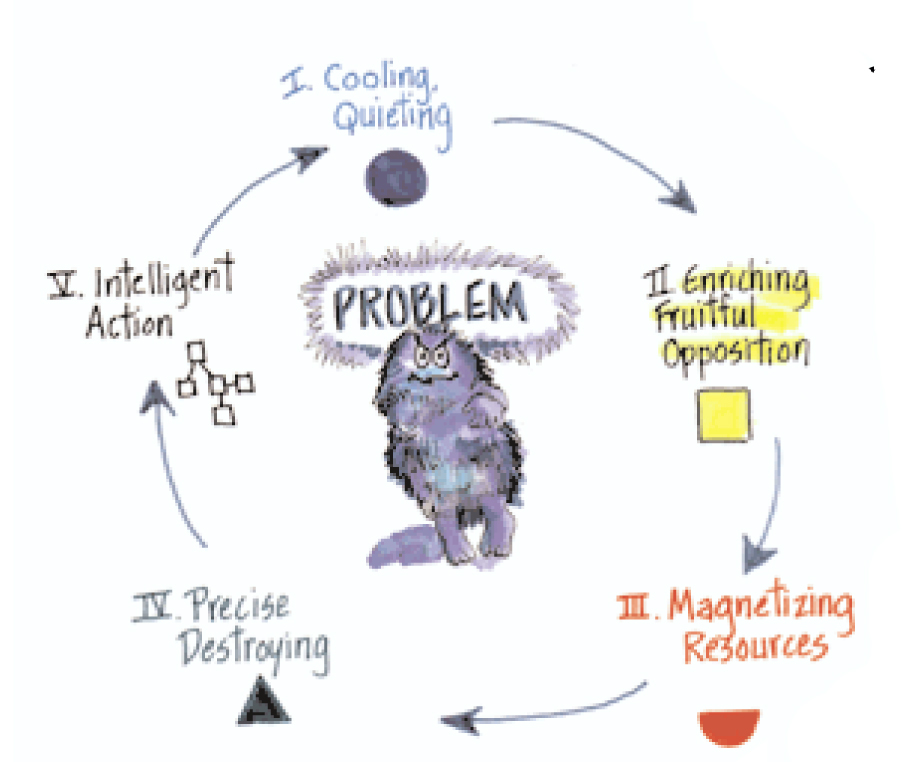
These five stages are depicted here as a cycle because they work developmentally, one stage creating the conditions for the next. This developmental sequence, however, can sometimes be gone through very quickly, or a group might spend a great deal of time in one stage and move rapidly through the next. Each stage has a form associated with it, a shape that provides the appropriate structure for the work at hand. Also, there are different core behaviors that facilitate the inquiry for each stage.
Stage One: Cooling, Quieting
Imagine your most recent experience in a conflicted situation. Most likely, people were arguing their position, not listening, raising their voices, acting out, doing power plays—in essence, acting aggressively. Nothing positive ever results from this continued conflict, yet we stay in it, unwilling to abandon the drama. Now imagine what might have been possible if someone had intervened with a process to lessen the drama, to cool down the situation. This first stage does just that, by using an ancient, pacifying form: the circle.
The circle is the shape that cools, quiets, pacifies (makes peaceful). It is the form of equality, the most common and enduring form of human meeting. Circles have been found from about 500,000 years ago, as early human ancestors sat around fires, trying to get warm. The equality of the circle was very important even then. Had they sat in a rectangle or any other form, some of them would have frozen!
To pacify a highly conflicted group, you have to move into a circle (or a number of small circles.) As soon as you sit in this form and it becomes clear that everyone will have a chance to speak, things quiet down. Anyone who persists in being dramatic or loud in a circle soon looks like a fool. Circles create soothing space, where even reticent people can realize that their voice is welcome. As the drama drains, people will still speak passionately, but more quietly and earnestly.
The process is quite straightforward. You go around the circle and everyone who wants to speaks does so, in turn, and within a limited time period. People who choose not to speak may pass and contribute later if they like. As each person speaks, everyone else is silent, listening as best they can. People may ask questions if they don’t understand something being said, but this is not the time for exchanges or debates. The task is to have each voice heard, for each person to make a contribution to the circle. (See endnote for additional resources on circle processes for large and small groups.)
There are many benefits to this process of listening. The first is that good listeners are created as people feel listened to. Listening is a reciprocal process—we become more attentive to others if they have attended to us. We are often surprised when people truly listen to us. Their unexpected acceptance encourages us to listen better.
The second benefit is that listening brings people together. You can see this happening physically in a circle. As people quiet down and get more engaged, they lean in. The circle becomes tighter. The room gets quieter, the volume decreases substantially, yet the intensity of listening is palpable.
And as we listen, we develop greater awareness that each of us is human, struggling with life’s challenges. One adage describes this:, “You can’t hate someone whose story you know.” We may never agree on an issue or share the same values, but as soon as we realize there’s a person behind the position, we become more open to them, less reactive.
The purpose of first quieting, calming, and pacifying is to develop a richer appreciation of the complexity of the problem, using a process that begins to bring people together. Every person has a somewhat different perspective, by virtue of individual differences, and also because we each sit in a different part of the organization or community. The world doesn’t look exactly the same to any two people, and circle provides the form to gather many different perspectives without as much judgment or defensiveness.
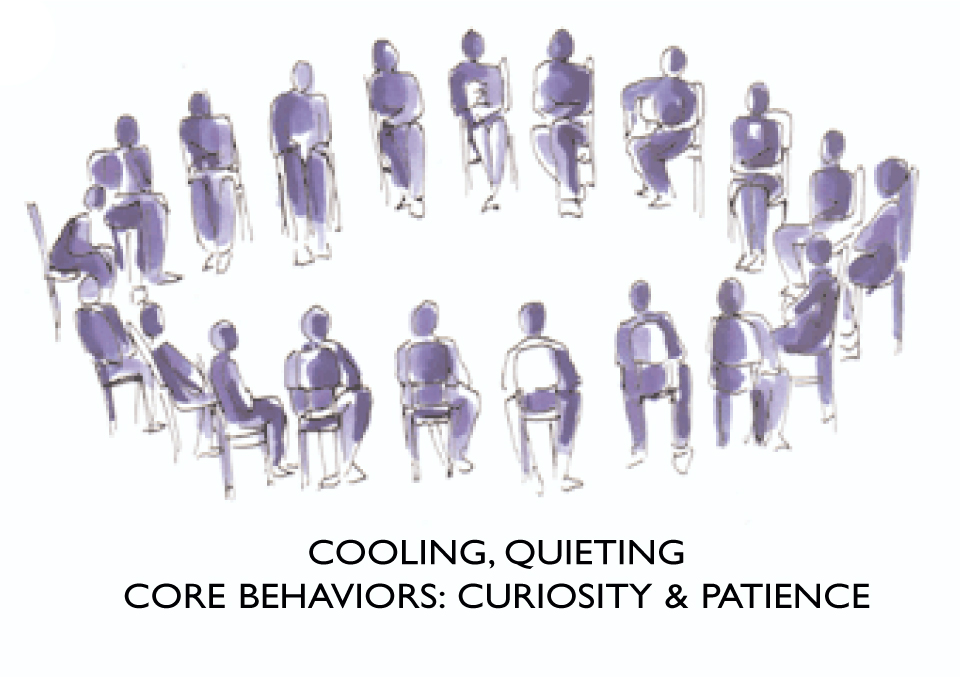
The core behaviors of this first process are patience and curiosity. We have to be willing to give up our soap boxes and become curious about others’ perspectives. And we have to be patient—it takes time to go round a circle and give everyone equal time. If we become impatient, it’s an indication that we’re still holding onto our position. We just want to get this over with so we can win using more aggressive approaches. But usually, what’s being said by others begins to awaken our curiosity. We learn things we didn’t know and develop more awareness of how other people are affected by the problem under consideration.
Stage Two: Enriching, Fruitful Opposition
After the initial process of cooling and quieting, it’s essential to return to the source of the conflict, which is people’s different perspectives and positions. In order to understand a problem in its complexity, we have to learn much more about it. We achieve this understanding by giving each person or position ample opportunity to explain their reasoning in depth. What’s required here is to amplify the differences as the means to create a fuller, detailed appreciation of the situation or problem. We are seeking to enrich our understanding from the realization that no one person or position has a sufficient picture of what’s going on.
To create this differentiation and depth, it helps to sit around a square table, to literally “take sides.” People need to choose which side they’re on (more than four sides is fine, as long as it doesn’t go beyond an octagon). They can switch sides as the process evolves. You can also do this seated as an audience, with each side presenting from the front. The fact that most public forums use such a form explains why they only increase conflict and entrenched positions. They begin by amplifying differences, rather then quieting and calming the situation. If you begin with taking sides, it’s guaranteed that you will only exacerbate the conflict.
Each side is responsible for developing their position in depth. This is not the time for sloganeering or campaigning. The task is to go deeply into the rationale and logic of each position. It is important to keep the exploration of each side separate—we are not seeking compromise, blending of views, consensus, or negotiations. Each position has its own logic, and the goal is to develop the unique integrity of each side.
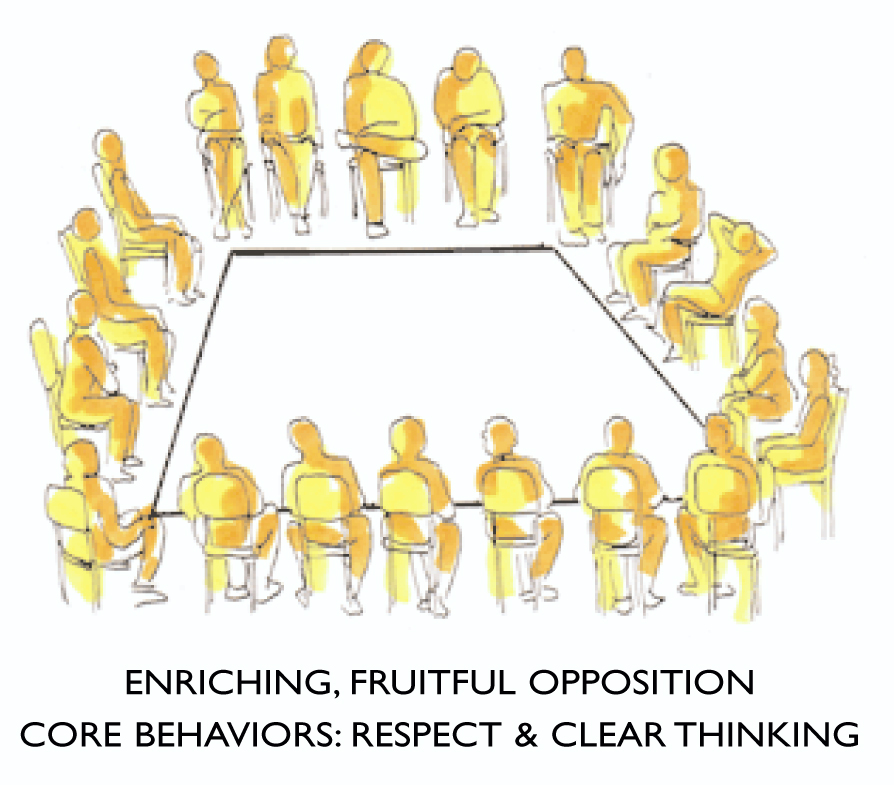
Respect and clear thinking are the core behaviors of this stage. We listen attentively, even to those whom we profoundly disagree with. Such respect is easier now that people have sat in circle together and developed more rapport and patience. Respect also means that we’re open to the possibility that we’ll hear something useful from our opponents. We are willing to be curious that others have insight and wisdom that are useful to the group.
And clear thinking is essential. We move away from emotions (no matter how much we care about the issue) and instead use reason to develop greater clarity about what’s going on. We want to clear away the fog created by our emotional investment in the issue. As each side presents its analysis of the problem, others simply listen. After a while, the inherent complexity of the situation becomes quite evident. Often, people are overwhelmed as they realize just how complex things really are. But this overwhelm is of great benefit, because it moves people off of their certainty platforms. Confused and overwhelmed, we become open to new interpretations and possibilities. Confusion often has a helpful companion, humility. Thus, confusion is the necessary precursor for letting go of entrenched positions and moving into creative exploration together.
At the end of this stage of differentiation and taking sides, you’ll notice that people begin to move out of the square or audience form and begin to cluster in messier ways because they want to talk with each other. One paradoxical consequence of exploring differences is that groups emerge at the other end feeling somewhat unified. The boundaries of the different positions have lost their hardness, and people begin to talk together as one cohesive group, wanting to resolve the problem together. This feeling of cohesiveness is an essential prerequisite for Stage Three, when it will be an important means to attract needed resources.
Stage Three: Magnetizing Resources
In magnetism, only opposites attract. Two magnets will repel apart if the same poles (or energy charge) are brought together. Yet when opposing magnetic poles are brought near each other, they snap together in a strong embrace. The same principle of attraction and rejection is relevant to this stage of problem solving.
After progressing through the stages of cooling and enriching, it is common for people to feel good about working together as a group, to be humbled by the complexity of the issue, and to be energized to move forward in finding a solution. It’s a complex array of predictable emotions. People will be both tired and motivated, confused yet confident. However, it’s also common for people at this stage to want to launch into action planning. Taking action relieves us of the oppressive feelings of confusion and overwhelm. We are eager to do anything rather than linger longer in these uncomfortable states.
However, if actions are determined at this stage, generally they will be the wrong ones. We do not yet have a sufficient understanding of the issue’s complexity to know what actions will be useful. If we rush into actions prematurely, we run the risk of setting in motion a long chain of unintended consequences. Stage Three takes us deeper into the issue, rather than letting us leap prematurely onto the stage of action.
The form that characterizes the work of Stage Three is a half-circle, a very humbling symbol. It indicates that however far we’ve come in our understanding of the problem, we’re only halfway there. Our comprehension of what’s going on is still incomplete, and we need many more perspectives and information to complete the circle of understanding.
As a result of working well through the first two processes, people feel more optimistic, confident that they can find the resources, information, and support they need. It’s true that groups at this stage do attract what they need. The source of this attraction is the shared understanding and cohesiveness of the group. As with real magnets, we’re creating one pole of sufficient strength to attract its opposite. The bond among ourselves and our clarifying picture of the problem can now draw in what’s missing. We will be able to attract an entirely new level of different and opposing points of view.
Generosity is also a core behavior of this stage. We’re no longer working in a reactive, self-protective mode. We’ve developed stronger relationships with colleagues and have increased our understanding. As our curiosity grows, as we move out of our bunkers, it becomes easier to feel open and welcoming. Humbled that we know only half of what we need to know, it’s easier to feel generous, welcoming new viewpoints and uncomfortable information.
To complete the circle of understanding, it can help to sit arrayed along the curve of a half-circle, facing out to the blank, uncompleted circle. You can put up flip charts or a white board in the empty half of the circle. It’s important to keep people focused on the blank space, not on each other. You can also draw a circle split down the middle. Fill in one side with a summary of your understanding. Leave the other side blank, to be filled in during this process.
A variety of questions help to fill in the blanks:
- What else is out there?
- Who else needs to be here?
- What are we blind to, what can’t we yet see?
- What additional information and perspectives do we need?
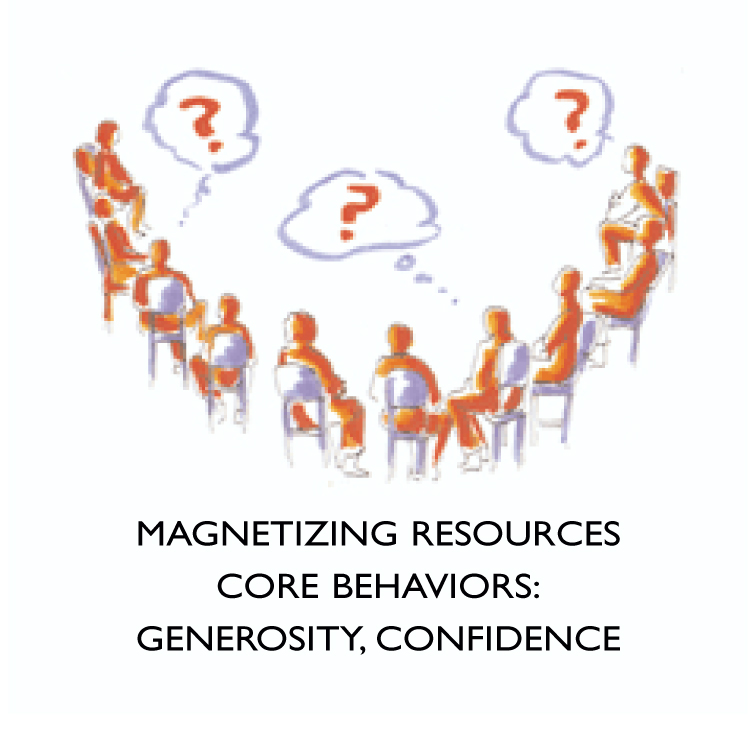
In answering these questions, the group is creating its next piece of work. Whoever is identified as missing has to be invited into the group. Whatever information is lacking has to be researched and brought in for deliberation. Time is required to go find the people, ideas, and resources that have been identified. It is important for the group to set a realistic but efficient timeline for this work.
Our willingness to acknowledge that we only see half the picture creates the conditions that make us more attractive to others. The more sincerely we acknowledge our need for their different insights and perspectives, the more they will be magnetized to join us. As our humility and openness becomes evident, and as our generosity grows, word gets out that we’re a good group to work with. This reputation also helps attract the people that we need to complete our circle of understanding.
Stage Four: Precise Destroying
Although we live in an aggressive culture, people often recoil from the word “destroying.” Yet if we look honestly at what’s going on in organizations, destroying is the most common response to organizational issues. And it’s the first response, rather than being the last action after careful consideration of the situation. Too many organizations use weapons of mass destruction rather than smart bombs. These WMDs include sweeping budget cuts, where everything is reduced rather than intelligent decisions to cut back in specific areas. Or massive layoffs. Or constant reorganizations that obliterate the most recent reorganization. We don’t seem to know how to act with precision; instead we routinely resort to carpet bombing.
Destroying is a necessary function in life. Everything has its season, and all things eventually lose their effectiveness and die. We do as much harm holding onto programs and people past their natural life span as we do when we employ massive organizational air strikes. However, destroying comes at the end of life’s cycle, not as a first response. Hence it is Stage Four here, coming after deep, thoughtful analysis by a group that is thinking well together. At this stage, precision destroying is necessary to create more capacity for the work going forward. We can see now what small elements of the situation are impeding movement forward, what few things need to be let go of as they are no longer necessary or appropriate for the work we must do.
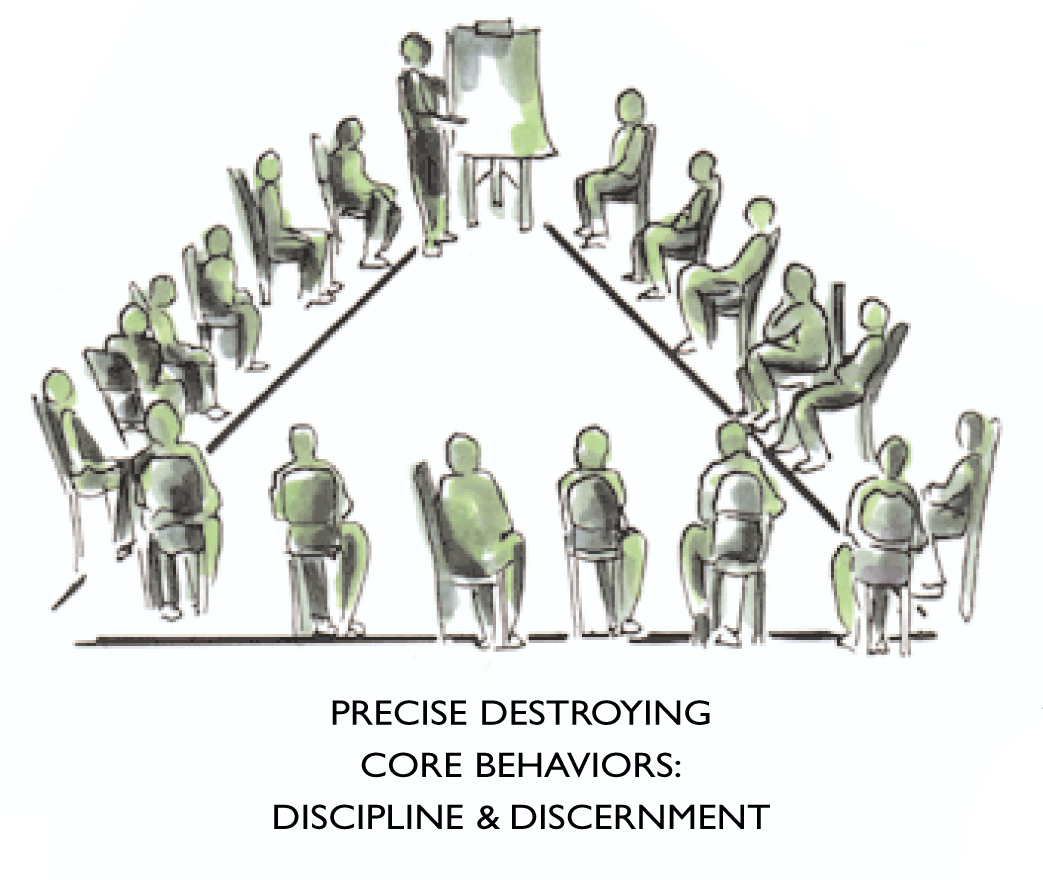
Many different things need to be considered for destruction: outmoded beliefs; inappropriate or harmful values; traditional practices that no longer make sense; habitual behaviors that are dysfunctional; aspects of the culture that impede future direction; programs that have outlived their usefulness; policies that don’t work as intended; specific individuals who refuse to change or who block progress.
At this stage in the problem-solving process, we can be trusted to act with precision and discipline. We are no longer reacting defensively, intent on getting rid of people and things that threaten us. We have a very clear picture of the problem and are able to use this new-found clarity to exercise real discernment. We act as intelligent and insightful contributors rather than as excluded or embattled members of the organization or community. We now are skilled enough to discern those small acts of destroying that will yield real benefit.
The form for Precision Destroying is the triangle. A triangle is a very stable structure, sitting on a broad base that supports its apex. The group can sit as a triangle, leaving the apex area open, with a flipchart or small whiteboard occupying that narrow point. Or people can draw a triangle and focus on the apex area. The core skills of this stage are discipline and discernment. We are restricted by the triangle to nominate only a small number of things to be destroyed in that narrow apex. We apply laser-like discernment to a very complex situation.
Precision destroying is naturally compassionate. We no longer act from self-defense, striking out at what we think harms us. We’re clear about which things impede solutions, which small elements hold us back or burden us with the past. When we determine what to destroy, we do so from a profound appreciation of the problem. We do not act from fear or anger, but from clarity and compassion.
Stage Five: Intelligently Acting
This last stage is the reward for working through the first four. We are now a cohesive, smart group of people who have developed genuine perspective and depth about the problem under consideration. We have become good systems thinkers because we’ve included so many diverse and contrasting views and information in our analysis. We can’t help but appreciate the dense interconnections and multiple dynamics at play in this situation. We’ve also developed very useful skills in working well together. We’ve become better listeners, become more open and curious, developed new thinking and analytic skills. We’ve also learned to work with people we had misunderstood, ignored, or feared. We’ve become a more intelligent, diverse, inclusive, and confident team, ready to go to work. The core behaviors of this stage are commitment and teamwork. We don’t have to create them or go off to be trained; they are the result of all the work we’ve done to get this far.
The form for this stage is the existing organization. Now is the time to use the processes that people are familiar with: action planning, strategy setting, project planning, budgeting, measuring. These processes have an important role to play. What’s been missing from them before is good thinking. Bored or exhausted, people have used them in rote fashion without insight or intelligence. Or they have been forced to use them in all situations, even those that make no sense. However, now these well-worn and tired processes can be infused with the light of clear thinking and the energy of strong commitment. Newly developed insights can be used to intelligently determine which actions, measures, and strategies make the most sense. Empowerment will occur naturally, as people proceed to change and discard existing processes and methods that are dysfunctional or nonsensical.
It’s important to note that leaders need to be prepared for big change. Once any group has developed this level of insight and rapport, they cannot be pushed back into small boxes or compliant behavior. With their intelligence awakened, people want to contribute, want to change things, want to make things happen. They will work with existing structures and processes, but they will be altering and adapting them as needed, almost without noticing. Too often, leaders fear a loss of control and attempt to rein in such a group. Their own fear pushes them back into aggressive patterns of command and control. However, the smart leader understands the level of accomplishment attained by this group and the depth of understanding now available. It is time to celebrate the fact that so much commitment and intelligence is now in active use in the organization.
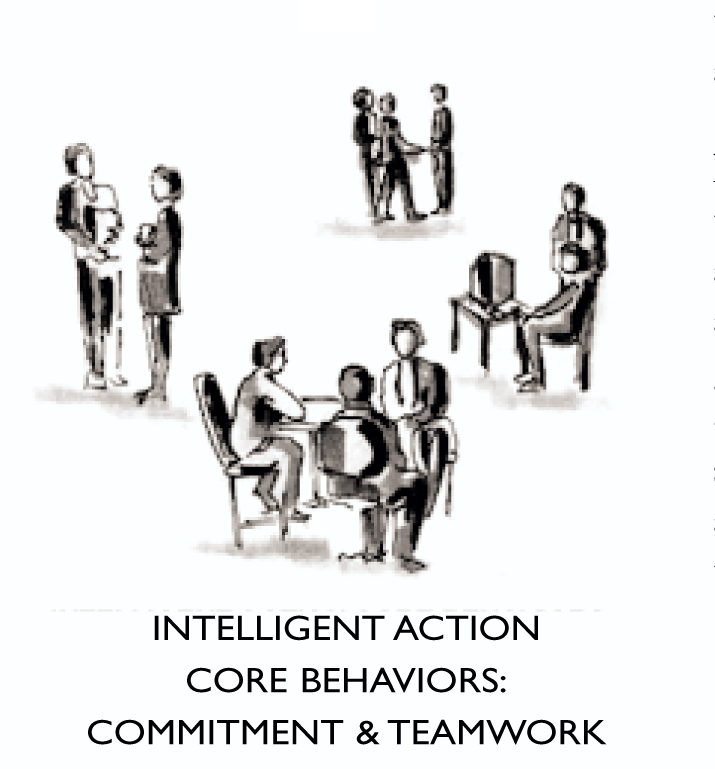
When we can lay down our fear and anger and choose responses other than aggression, we create the conditions for bringing out the best in us humans. Without aggression, it becomes possible to think well, to be curious about differences, and to enjoy each other’s company. Our energy finds new channels in creativity rather than defense. We learn that it is possible to feel passionate about a position without having to resist or outmaneuver those with differing passions.
As we strive to make our organizations and communities work decently in these difficult times, if we are to find true solutions to the problems that afflict us, it is essential that we understand the price we pay for our aggressive methods. If we are to work together more intelligently, we will need to choose processes that evoke our curiosity, humility, generosity, and wisdom. The ultimate benefit is that we learn that it is good, once again, to work together.
Margaret Wheatley, Ed. D., writes, teaches, and speaks about radically new practices and ideas for organizing in chaotic times. She is president of the Berkana Institute, a charitable global leadership foundation serving life-affirming leaders, and has been an organizational consultant for many years, as well as a professor of management in two graduate programs. Her newest book is Finding Our Way: Leadership for an Uncertain Time (BerrettKoehler, 2005. Her book, Turning to One Another: Simple Conversations to Restore Hope to the Future (January 2002), proposes that real social change comes from the ageless process of people thinking together in conversation. Wheatley’s work also appears in two award-winning books, Leadership and the New Science (1992, 1999) and A Simpler Way (with Myron Kellner-Rogers, 1996,) plus several videos and articles.
Geoff Crinean, Ph. D., is president of Business Insight International, a business and life coach, and a leader of workshops on leadership principles, awareness development, and life fulfillment. He has been consulting with and mentoring people in business for 30 years in Canada, the United States, the United Kingdom, South Africa, and Australia— in industries such as engineering, information technology and software development, mining, and finance. In parallel with his business life, for the past 30 years, Geoff has studied and practiced meditation and the principles of Buddhism.
NOTE: To learn a variety of processes for using circle with both large and small groups, see www.turningtooneanother.net. This site was created by Margaret Wheatley and has downloadable guides for different circle processes, book references, articles, and a listing of many different organizations and communities that use circle processes.
